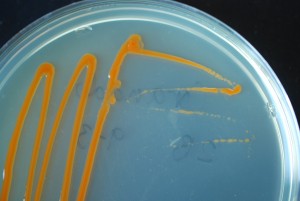Isolating interesting bacteria and sequencing their genomes has never been easier and our lab has worked extensively on this topic, particularly in the context of undergraduate education. Our first foray into this field came in 2011 with a group of students working on the “Built Environment Genomes Project” and eventually culminated in our Swabs to Genomes publication which we hope will serve as a toolkit for future efforts of this type. This Spring we’ll actually be attempting to take a class of 20 students from colonies on a plate to sequenced/assembled/annotated genomes within a 10-week quarter. More on that later.
So I was very excited when Jonathan Eisen directed me towards a paper called “Sequencing and characterizing the genome of Estrella lausannensis as an undergraduate project: training students and biological insights” by a group in Lausanne, Switzerland. (Full disclosure, they cite our Built Environment Project in the paper).

Basically they took a group of Master’s students and had them assemble a couple different genomes, including Estrella lausannensis. Their version of this process is more slanted towards the bioinformatics end of things and less towards the microbiology end of things than our version. For example they have the students perform multiple assemblies for comparison and even undertook PCR-based gap filling and manual annotation of genes. It sounds like the students had a great time and thought highly of the course. We’d love to see more of these efforts out there… if you know of any more please send them our way!
Here’s the abstract containing all the good stuff:
With the widespread availability of high-throughput sequencing technologies, sequencing projects have become pervasive in the molecular life sciences. The huge bulk of data generated daily must be analyzed further by biologists with skills in bioinformatics and by “embedded bioinformaticians,” i.e., bioinformaticians integrated in wet lab research groups. Thus, students interested in molecular life sciences must be trained in the main steps of genomics: sequencing, assembly, annotation and analysis. To reach that goal, a practical course has been set up for master students at the University of Lausanne: the “Sequence a genome” class. At the beginning of the academic year, a few bacterial species whose genome is unknown are provided to the students, who sequence and assemble the genome(s) and perform manual annotation. Here, we report the progress of the first class from September 2010 to June 2011 and the results obtained by seven master students who specifically assembled and annotated the genome of Estrella lausannensis, an obligate intracellular bacterium related to Chlamydia. The draft genome of Estrella is composed of 29 scaffolds encompassing 2,819,825 bp that encode for 2233 putative proteins. Estrella also possesses a 9136 bp plasmid that encodes for 14 genes, among which we found an integrase and a toxin/antitoxin module. Like all other members of the Chlamydiales order, Estrella possesses a highly conserved type III secretion system, considered as a key virulence factor. The annotation of the Estrella genome also allowed the characterization of the metabolic abilities of this strictly intracellular bacterium. Altogether, the students provided the scientific community with the Estrella genome sequence and a preliminary understanding of the biology of this recently-discovered bacterial genus, while learning to use cutting-edge technologies for sequencing and to perform bioinformatics analyses.
